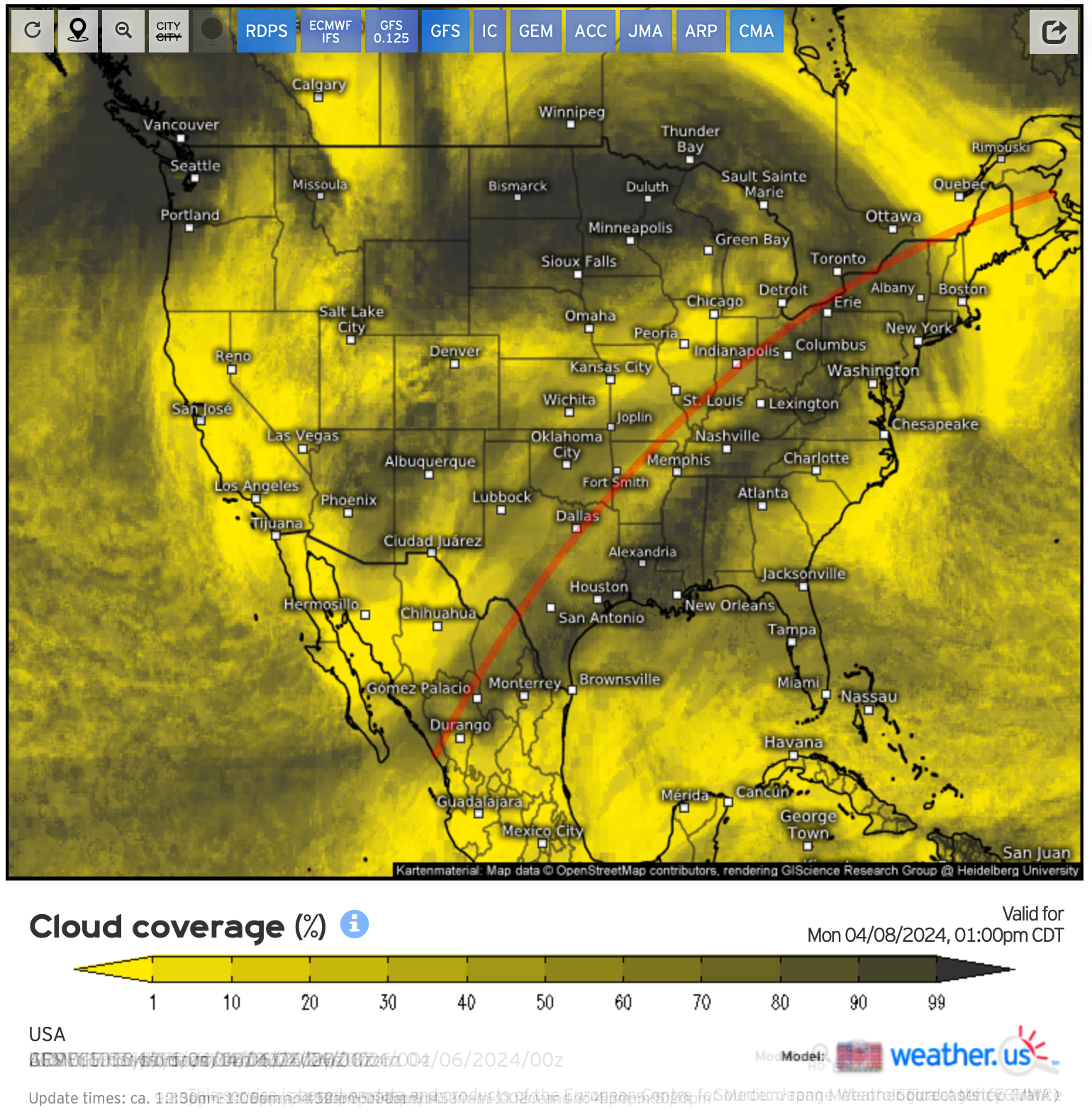Eclipse Day Cloud Coverage Model at T-60 Hours
One last update before I head out to San Antonio!
Overall, the models have begun to agree much more for most (but not all!) of the zone of totality as the line of clouds is a lot more well defined on the mean stack compared to past runs.
It looks like if you rolled the dice and chose to head to Maine, you’re going to be the “winner” of this eclipse.
But don’t fret, there’s still plenty of opportunity across the zone of totality.
Aaand! Texas is starting to look a bit friendlier. More on that in a bit!
T-60 Hours Mean
Links to the original content:
https://weather.us/model-charts/euro/usa/total-cloud-coverage/20240408-1800z.html
https://weather.us/model-charts/gfs-hd/usa/total-cloud-coverage/20240408-1800z.html
https://weather.us/model-charts/german/usa/total-cloud-coverage/20240408-1800z.html
https://weather.us/model-charts/can/usa/total-cloud-coverage/20240408-1800z.html
https://weather.us/model-charts/aus/usa/total-cloud-coverage/20240408-1800z.html
https://weather.us/model-charts/jpn/usa/total-cloud-coverage/20240408-1800z.html
https://weather.us/model-charts/french/usa/total-cloud-coverage/20240408-1800z.html
https://weather.us/model-charts/cma/usa/total-cloud-coverage/20240408-1800z.html
https://weather.us/model-charts/can-regional/usa/total-cloud-coverage/20240408-1800z.html
Unfortunately, with the eastward push of the line of clouds, those headed to Northeast Ohio and Western New York are potentially in for a cloud afternoon.
Here’s the model above with an approximation of the eclipse centerline.
T-60 Mean with Reference Line
The eastward drift of the cloud line really becomes apparent when you look at the maximum forecast (bright yellow indicating areas where at least one model calls for clear skies):
T-60 Hours Maximum
That said, there’s still some disagreement with the forecasted minimum map (where black indicates where at least one model calls for total cloud cover):
T-60 Hours Minimum with Reference Line
As you can see, the only slam-dunk area to see totality is going to be Maine and Quebec.
Don’t fret, however, if you are anywhere else along the line of totality as you still have a chance of seeing a fully eclipsed sun.
The key will be flexibility on eclipse day, and you can read how to maximize your chances of success in my how-to guide: How to Choose a Solar Eclipse Viewing Location.
Probably the most profound development in the last few hours has been the improvement with the forecast in parts of Texas. I know many of you have been sweating this, so I’ll dig into this a bit deeper:
T-60 Mean (Texas)
We have witnessed a significant improvement in the forecast in the Dallas Metro Area over the last 24 hours. Even areas west of San Antonio have had their chances increased.
It is important to remember: Texas remains -by far- the region where cloud uncertainty is greatest. All the same, it is great to see more models predicting some cloudless parts of the state:
T-60 Maximum (Texas)
Hang in there!
P.S. - I’m not sure when my next post is going to be given my travel to Texas, but I suspect I’ll be able to sneak in a few more posts between now and Monday morning … since I’ll be on a laptop, fair warning they may not be as detailed as these ones have been.
—————
Disclaimers: The information from weather.us included herein is done in a manner consistent with its terms and conditions, which you can read here. H.D. Hunt Photography is a noncommercial website and recognizes the copyright for this material is retained by the originator.
You can support H.D. Hunt Photography through a follow on Instagram:





